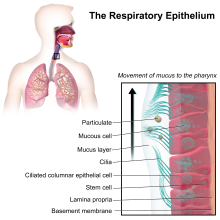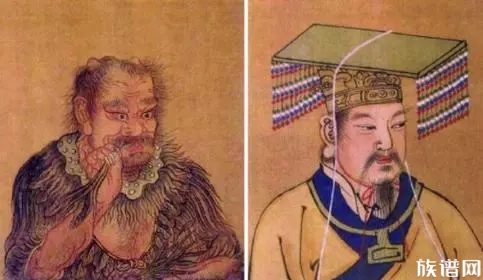



鼻涕
呼吸系统

Illustration depicting the movement of mucus in the respiratory tract.
In the human respiratory system, mucus aids in the protection of the lungs by trapping foreign particles that enter them, in particular, through the nose, during normal breathing. "Phlegm" is a specialized term for mucus that is restricted to the respiratory tract, whereas the term "nasal mucus" describes secretions of the nasal passages.
Nasal mucus is produced by the nasal mucosa; and mucosal tissues lining the airways (trachea, bronchus, bronchioles) is produced by specialized airway epithelial cells (goblet cells) and submucosal glands. Small particles such as dust, particulate pollutants, and allergens, as well as infectious agents andbacteriaare caught in the viscous nasal or airway mucus and prevented from entering the system. This event along with the continual movement of the respiratory mucus layer toward the oropharynx, helps prevent foreign objects from entering the lungs during breathing. This explains why coughing often occurs in those who smoke cigarettes. The body"s natural reaction is to increase mucus production. In addition, mucus aids in moisturizing the inhaled air and prevents tissues such as the nasal and airway epithelia from drying out. Nasal and airway mucus is produced continuously, with most of it swallowed subconsciously, even when it is dried.
Increased mucus production in the respiratory tract is a symptom of many common illnesses, such as the common cold and influenza. Hypersecretion of mucus can occur in inflammatory respiratory diseases such as respiratory allergies,asthma, and chronic bronchitis. The presence of mucus in the nose and throat is normal, but increased quantities can impede comfortable breathing and must be cleared by blowing the nose or expectorating phlegm from the throat.
Diseases involving mucus
In general, nasal mucus is clear and thin, serving to filter air during inhalation. During times of infection, mucus can change color to yellow or green either as a result of trappedbacteria or due to the body"s reaction toviralinfection. The green color of mucus comes from the heme group in the iron-containing enzyme myeloperoxidase secreted by white blood cells as a cytotoxic defense during a respiratory burst.
In the case of bacterial infection, the bacterium becomes trapped in already-clogged sinuses, breeding in the moist, nutrient-rich environment. Sinusitis is an uncomfortable condition which may include congestion of mucus. A bacterial infection in sinusitis will cause discolored mucus and would respond to antibiotic treatment; viral infections typically resolve without treatment. Almost all sinusitis infections are viral and antibiotics are ineffective and not recommended for treating typical cases.
In the case of a viral infection such as cold or flu, the first stage and also the last stage of the infection cause the production of a clear, thin mucus in the nose or back of the throat. As the body begins to react to the virus (generally one to three days), mucus thickens and may turn yellow or green. Viral infections cannot be treated with antibiotics, and are a major avenue for their misuse. Treatment is generally symptom-based; often it is sufficient to allow the immune system to fight off the virus over time.
Cystic fibrosis
Cystic fibrosis is an inherited disease that affects the entire body. Symptoms begin mostly in the lungs, with viscous (thick) mucus that is difficult to expel.
Mucus as a medical symptom
Increased mucus production in the upper respiratory tract is a symptom of many common ailments, such as the common cold. Nasal mucus may be removed by blowing the nose or by using nasal irrigation. Excess nasal mucus, as with a cold or allergies, due to vascular engorgement associated with vasodilation and increased capillary permeability caused by histamines, may be treated cautiously with decongestant medications. Excess mucus production in the bronchi and bronchioles, as may occur inasthma, bronchitis or influenza, may be treated with anti-inflammatory medications as a means of reducing the airway inflammation, which triggers mucus over-production. Thickening of mucus as a "rebound" effect following overuse of decongestants may produce nasal or sinus drainage problems and circumstances that promote infection.
Cold weather and nasal mucus
During exposure to cold weather, the cilia, which normally sweep mucus away from the nostrils and toward the back of the throat (see respiratory epithelium), become sluggish or completely cease functioning. This results in mucus running down the nose and dripping (a runny nose). Mucus also thickens in cold weather; when an individual comes in from the cold, the mucus thaws and begins to run before the cilia begin to work again.
消化系统
In the human digestive system, mucus is used as a lubricant for materials that must pass over membranes, e.g., food passing down theesophagus. Mucus is extremely important in the intestinal tract. It forms an essential layer in the colon and in the small intestine that helps reduce intestinal inflammation by decreasing bacterial interaction with intestinal epithelial cells. A layer of mucus along the inner walls of thestomachis vital to protect the cell linings of that organ from the highly acidic environment within it. Mucus is not digested in the intestinal tract. Mucus is also secreted from glands within the rectum due to stimulation of the mucous membrane within.
生殖系统
In the human female reproductive system, cervical mucus prevents infection and provides lubrication during sexual intercourse. The consistency of cervical mucus varies depending on the stage of a woman"s menstrual cycle. At ovulation cervical mucus is clear, runny, and conducive to sperm; post-ovulation, mucus becomes thicker and is more likely to block sperm. Several Fertility Awareness methods, such as the Creighton Model and Billings method rely on this fact to prevent or to improve the odds of pregnancy.
In the human male reproductive system, the seminal vesicles contribute up to 100% of the total volume of the semen and contain mucus, amino acids, prostaglandins, vitamin C, andfructoseas the main energy source for the sperm.
鼻涕的成分
鼻涕的主要成分:水分、无机盐、少量糖、脂肪、蛋白质、少量脱落的粘膜细胞、吸附的灰尘和空气中的化学物质等。这也是生病时大量细菌会寄生其中, 使鼻涕呈现黄色或绿色的原因。
有色鼻涕
鼻涕一般是无色透明黏液,但鼻涕颜色若呈现淡黄色或淡绿色,且变浓稠状,这代表鼻腔可能受到细菌或病毒感染。当细菌感染时,细菌在鼻腔内大量滋生,免疫反应导致鼻黏膜肿胀,因而产生鼻塞。据英国彼士顿研究所一个研究人体分泌液的研究小组调查,在3000名志愿者身上发现有5%的志愿者有其他颜色的鼻涕,如红色,棕色,紫色等。该研究小组解释,可能是因为人类个体免疫系统变异导致该结果,而这种结果又是由于病菌和病毒的进化导致的。
参见
空鼻症候群
Alkaline mucus
Empty nose syndrome
Mucoadhesion
Mucophagy
Snail slime
Sniffle
Spinnbarkeit
References
免责声明:以上内容版权归原作者所有,如有侵犯您的原创版权请告知,我们将尽快删除相关内容。感谢每一位辛勤著写的作者,感谢每一位的分享。

- 有价值
- 一般般
- 没价值








推荐阅读


关于我们

APP下载



















